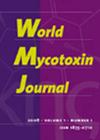在半乳糖补充的培养基中用伏马菌素B1处理的HepG2肝细胞改变了已知调节胆固醇流量的基因和蛋白质的表达
IF 1.7
4区 医学
Q3 FOOD SCIENCE & TECHNOLOGY
引用次数: 2
摘要
伏马菌素B1(FB1)导致动物的真菌中毒,并与人类某些癌症的发生率有关。FB1对脂质组学特征、鞘脂和胆固醇水平的影响已在实验模型中得到证实,但导致胆固醇水平改变的事件尚不清楚。本研究探讨了调节FB1对半乳糖补充的HepG2肝细胞胆固醇稳态影响的分子机制。补充半乳糖是一种已被证实的方法,用于规避癌症细胞表现出的Crabtree效应,该效应迫使癌症细胞激活线粒体。HepG2细胞在补充半乳糖的培养基中培养,并用FB1(IC50=25μM)处理6小时。使用MTT法测定细胞活力。使用ATP萤光素酶测定法评估代谢状态,并使用蛋白质印迹和qPCR研究胆固醇调节转录因子(SIRT1、SREBP-1C、LXR、LDLR、PCSK9和ABCA1)。FB1在添加半乳糖的HepG2细胞中增加SIRT1、SREBP-1C、LXR和LDLR的基因表达(P<0.05);PCSK9下降(P<0.05)。此外,FB1处理后SIRT1、LXR和LDLR的蛋白表达升高,而SREBP-1C和PCSK9的蛋白表达降低。该数据提供了SIRT1降低PCSK9和去乙酰基化LXR的表达以防止LDLR降解的证据。这可能导致胆固醇流量失调,这可能导致FB1介导的毒性。本文章由计算机程序翻译,如有差异,请以英文原文为准。
HepG2 liver cells treated with fumonisin B1 in galactose supplemented media have altered expression of genes and proteins known to regulate cholesterol flux
Fumonisin B1 (FB1) contributes to mycotoxicosis in animals and has been associated with the incidence of some cancers in humans. The effect of FB1 on lipidomic profiles, sphingolipids and cholesterol levels have been demonstrated in experimental models, however, the events leading to altered cholesterol levels are unclear. This study investigates the molecular mechanisms that regulate the effect of FB1 on cholesterol homeostasis in galactose supplemented HepG2 liver cells. Galactose supplementation is a proven method utilised to circumvent the Crabtree effect exhibited by cancer cells, which forces cancer cells to activate the mitochondria. HepG2 cells were cultured in galactose supplemented media and treated with FB1 (IC50 = 25 μM) for 6 h. Cell viability was determined using the MTT assay. Metabolic status was evaluated using ATP luciferase assay, and cholesterol regulatory transcription factors (SIRT1, SREBP-1C, LXR, LDLR, PCSK9, and ABCA1) were investigated using western blotting and qPCR. FB1 in galactose supplemented HepG2 cells increased gene expression of SIRT1 (P<0.05), SREBP-1C, LXR, and LDLR; however, PCSK9 (P<0.05) was decreased. Furthermore, protein expression of SIRT1, LXR, and LDLR was elevated upon FB1 treatment, while SREBP-1C and PCSK9 were reduced. The data provides evidence that SIRT1 reduced the expression of PCSK9 and deacetylated LXR to prevent degradation of LDLR. This could result in a dysregulated cholesterol flux, which may contribute to FB1 mediated toxicity.
求助全文
通过发布文献求助,成功后即可免费获取论文全文。
去求助
来源期刊

World Mycotoxin Journal
MYCOLOGY-
CiteScore
4.60
自引率
5.00%
发文量
25
审稿时长
>12 weeks
期刊介绍:
''World Mycotoxin Journal'' is a peer-reviewed scientific journal with only one specific area of focus: the promotion of the science of mycotoxins. The journal contains original research papers and critical reviews in all areas dealing with mycotoxins, together with opinions, a calendar of forthcoming mycotoxin-related events and book reviews. The journal takes a multidisciplinary approach, and it focuses on a broad spectrum of issues, including toxicology, risk assessment, worldwide occurrence, modelling and prediction of toxin formation, genomics, molecular biology for control of mycotoxigenic fungi, pre-and post-harvest prevention and control, sampling, analytical methodology and quality assurance, food technology, economics and regulatory issues. ''World Mycotoxin Journal'' is intended to serve the needs of researchers and professionals from the scientific community and industry, as well as of policy makers and regulators.
 求助内容:
求助内容: 应助结果提醒方式:
应助结果提醒方式:


